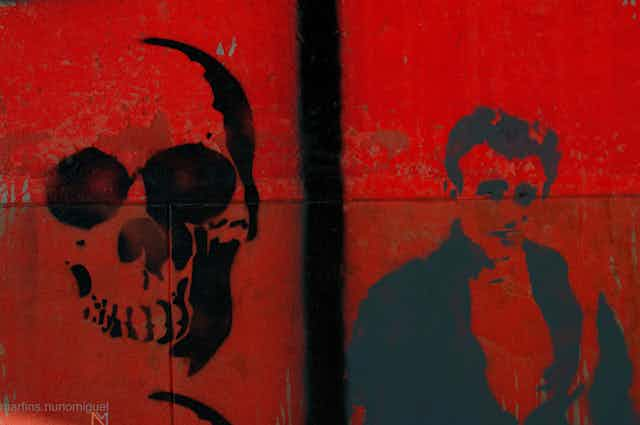Prince Charming and the boy accused of the Boston bombings may not seem to have much in common. But thousands of teenage American girls appear to be falling in love with 19-year-old Dzhokhar Tsarnaev, and the explanation may lie in a very awkward place indeed – somewhere between the shining armour and the poisoned apple.
Tsarnaev has become the focal point for a number of fan clubs on social media, largely comprising teenage girls protesting his innocence and professing undying love. Two Facebook groups have 8,400 and 13,500 members respectively.
Teenage girls are reported to be leaving messages of love for Tsarnaev. One young fan announced on Twitter she wanted to have his words tattooed on her arm.

Some commentators have said that the girls are acting out fantasies of being famous by aligning themselves with a notorious criminal. Others suggest that they are simply rebelling against authority.

There is also much existing research about Stockholm Syndrome and its variations, including women who are attracted to infamous criminals, terrorists, murderers, rapists etc. All of these are no doubt a part of what is driving pro-Tsarnaev sentiments among young girls.
And yet I find myself wondering if it might be symptomatic of a wider social issue. While – clearly – not all young women are falling for Tsarnaev, there are enough to suggest something may be going on that is bigger than a few misguided teenage girls wanting to raise a middle finger at authority in a very public way.

Social roles theories
What does it say about our society that a potential terrorist can have such widespread appeal to young women? One perspective comes out of social role theory and ambivalent sexism theory. These theories suggest that we are a product of the social roles we inhabit, and I think this might add another piece to the puzzle of teenage girls’ infatuation with Tsarnaev.

The plot of social roles theories is more convoluted than a Mozart opera, but here are the sharps and flats of it: the foundation of social psychology professor Alice Eagly’s theory is that we’ve come to associate men with being physically strong, dominant, competitive, aggressive and assertive.
Women, on the other hand, are identified more readily with being caring, nurturing, unaggressive, dependant and communal.
Peter Glick and Susan Fiske, both professors of psychology, take this a step further with ambivalent sexism theory.
They suggest that modern benevolent sexism portrays men as providers and protectors for women. Women who value masculine power and who place themselves under the protection of a male are rewarded with approbation and approval. Women who do not are censured with disapproval and dislike.
The result is a gendered power imbalance in heterosexual relationships where men are physically, socially, and financially dominant, while also depending on women for intimacy, reproduction and caregiving.
This is an uncomfortable dependency for any dominant person or group. After all, if you’re going to dominate another sector of society, you don’t really want to have to rely on them for any goodwill, right?

So there needs to be a sweetener for the pill. Another psychology professor, Laurie Rudman, identified it by linking the provider-protector role with the romantic idealisation of potential partners.
Enter Prince Charming
Fairy tale notions of Prince Charming and knights in shining armour help to maintain stereotyped ideas of men as strong, dominant, competitive and powerful - and therefore desirable as protectors.
The same fairy tale notions place women in dependant roles where charming (and not-so-charming) princes can protect them. You don’t need to go very far to find a myriad of examples of fairy tales being spoon-fed to children (and adults) in everyday life.

Think Twilight, Die Hard, Skyfall … even Star Wars was ultimately a story of heroes rescuing a damsel in distress, albeit a rather feisty one with a disturbed hairdresser.
Young women and young men have come to idealise the heroes who will go to any lengths of violence or sacrifice to save the damsel and/or the world. In doing so, it may be that Prince Charming – for some – has morphed into an altogether more sinister proposition.
If you’re not minded to examine your chosen Prince Charming too closely, Tsarnaev appears to be socially dominant and powerful, and therefore a prime candidate for protector.
He has natural appeal for adolescent girls because he is of their age group, has been described as “too beautiful to be a terrorist”, and is attributed with statements such as:

Big tick for stereotyped Prince Charming superhero.
So, young women’s reactions to Tsarnaev, at an individual level, are no doubt associated with fame and rebellion. But teenage girls’ infatuation with Tsarnaev may also be an extreme example of the roles that women and men are expected to play in our world.
Romantic fantasies of heroes can leave women vulnerable to “dangerous men”, whether of the celebrity boyfriend type or the closer-to-home domestic abuser. Viewed like this, it’s not so surprising that Tsarnaev fan clubs have popped up, and that adolescent girls are romanticising him to such an extent.

